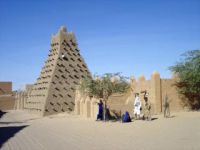Timbuktu: Reconstruction of World Heritage Sites
Timbuktu, in Mali, was a centre of culture and learning in the fifteenth and sixteenth centuries. Its rich mausoleums bear witness to the fact that it was also an economic and spiritual centre. Islamist extremists invading the region in 2012 destroyed the monuments. Today, their reconstruction is launched.

Timbuktu is famous for its three great mosques, Djingareyber, Sankore and Sidi Yahia but it is also famous for its ancient mausoleums, described by UNESCO as "exceptional examples of earthen architecture", which needed regular upkeep due to the winds blowing sand across the desert. Sixteen of these mausoleums are part of the UNESCO World Heritage site.
During the occupation of the region by Islamist fundamentalists in 2012, the residents were stopped from performing the maintenance works and the extremists started to destroy the mausoleums in Timbuktu (Tim-buktu, place of the old lady, named Buktu) which was founded in the fifth century and one thousand years later, was to become a centre for the teaching of Islam and Islamic culture. Lying in a strategic position intersected by several trading routes, it became a centre for the trading of manuscripts, gold, salt and cattle and by the sixteenth century, had 100,000 residents.
25,000 students attended its Koranic schools and Madrassas, training architects, engineers, cartographers, mathematicians and scholars, a meeting place for intellectuals from the four corners of the Earth.
This magnificent heritage and witness of this city's tremendously important past, which has been preserved by its residents throughout the centuries, saw an ugly and unexpected turn in 2012 when Islamist Salafist fundamentalists - Ansar Dine - started destroying the structures they considered as idolatrous because they did not agree with the veneration of saints, venerated by Sufi Moslems.
The mausoleums were attacked with pickaxes and several ancient shrines were destroyed, turned into piles of rubble. Those who complained had their hands cut off so that they could not restore the monuments.
The reconstruction work is to last around one month. The Imam of Djingareyber will oversee the works, carried out by a group of local stonemasons, financed by UNESCO and the Government of Mali, with further contributions from Andorra, the Kingdom of Bahrain, Croatia and Mauritius as well as logistical support from the United Nations Multidimensional Integrated Stabilization Mission in Mali (MINUSMA).
"The rehabilitation of the cultural heritage of Timbuktu is crucial for the people of Mali, for the city's residents and for the world. The name of Timbuktu sparks the imagination of millions of people in all parts of the planet and it is a happy day for us at UNESCO when we see the support we have helped mobilize for the people and culture of this part of the world crowned with success," stated Irina Bokova, Director-General of UNESCO.
Timothy Bancroft-Hinchey
Pravda.Ru
Subscribe to Pravda.Ru Telegram channel, Facebook, RSS!

